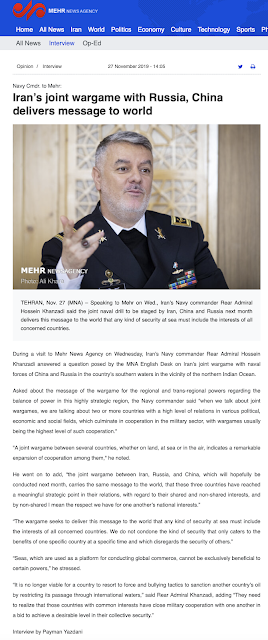Here is a recent news report from Iran's Mehr News Agency:
Note the following quote:
“The joint wargame between Iran, Russia, and China, which will hopefully be conducted next month, carries the same message to the world, that these three countries have reached a meaningful strategic point in their relations, with regard to their shared and non-shared interests, and by non-shared I mean the respect we have for one another’s national interests…
Seas, which are used as a platform for conducting global commerce, cannot be exclusively beneficial to certain powers. It is no longer viable for a country to resort to force and bullying tactics to sanction another country’s oil by restricting its passage through international waters. They need to realize that those countries with common interests have close military cooperation with one another in a bid to achieve a desirable level in their collective security.” (my bolds)
These joint naval war-games which are scheduled to take place in December 2019 were also reported by two of Washington's propaganda radio broadcasting networks:
2.) Radio Farda: The Iranian branch of the United States government-funded Radio Free Europe/Radio Liberty which broadcasts to Iranian listeners in Farsi:
Given the growing naval partnership between the three nations, let's look at what Global Firepower has to say about the strength of each nation's naval forces when measured in terms of total naval assets, a measurement that is not entirely accurate since each asset is given equal value:
1.) Russia: Total Naval Assets - 352 putting them in fifth place overall when measured in terms of the number of naval assets.
Aircraft Carriers - 1
Frigates - 13
Destroyers - 13
Corvettes - 82
Submarines - 58
Patrol Vessels - 45
Mine Warfare - 47
2.) China: Total Naval Assets - 714 putting them in second place overall when measured in terms of the number of naval assets.
Aircraft Carriers - 1
Frigates - 52
Destroyers - 33
Corvettes - 42
Submarines - 76
Patrol Vessels - 192
Mine Warfare - 33
3.) Iran: Total Naval Assets - 398 putting them in fourth place overall when measured in terms of the number of naval assets.
Aircraft Carriers - 01
Frigates - 6
Destroyers - 0
Corvettes - 3
Submarines - 34
Patrol Vessels - 88
Mine Warfare - 3
Now, let's look at the naval assets of the United States which has a total of 415 naval assets putting them in third place overall:
Aircraft Carriers - 24
Frigates - 22
Destroyers - 68
Corvettes - 15
Submarines - 68
Patrol Vessels - 13
Mine Warfare - 11
As you can see, while the United States has far fewer total naval assets than the combination of Russia, China and Iran, its naval assets are more formidable. That said, this is the damage that a small boat loaded with explosives was able to do to the USS Cole, a United States Navy Arleigh Burke-class destroyer which was only four years old at the time of the attack, as it was refuelling in Yemen in October 2000:
It took 14 months to repair the Cole. This example shows us how even the most technologically advanced and formidable United States naval vessels are vulnerable to attacks by the smallest and least technologically advanced vessels that are part of other nations' naval assets.
The naval war-games that are scheduled to take place with Iran, Russia and China should give Washington a good reason to rethink any plans that it has for a military intervention in Iran with the goal of regime change. Given this development, it is highly unlikely that Iran will find itself fighting against the United States on its own.










No comments:
Post a Comment